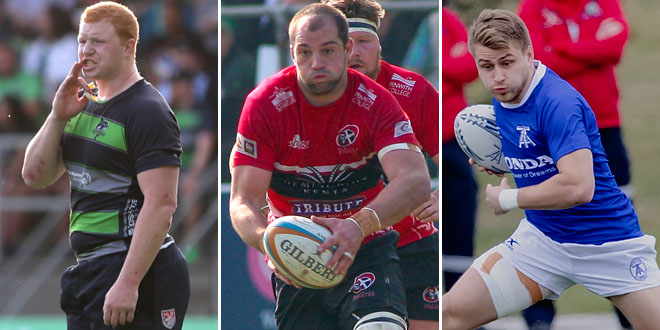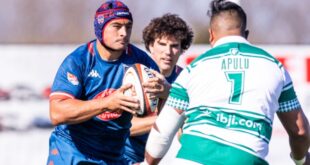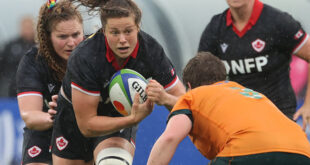Debate inevitably follows each Rugby World Cup squad announcement. Yesterday we covered Argentina’s missing men, today we look to Canada. Look for Uruguay’s side tomorrow with the USA coming on Friday. Players eligible include all those who remain active, including those injured, retired from international duty, or simply overlooked.
The 31 players named by Kingsley Jones have been met with mixed reviews from rugby critics in the north. While it’s true that much of the squad ‘picks itself’, the increase in professional talent due largely to Major League Rugby has, for the first time, given the team options. In fact several decisions seem to go against Jones’ own words just a year ago when he left out several top players during the June test series on the demands that they get more playing time in the pro ranks.
1 – Rob Brouwer (Toronto Arrows) There were four Canadian loosehead props starting for MLR teams, and Brouwer was virtually unanimously considered to be the best of those on form. The test experience of Hubert Buydens looks to have given him the nod, with Jones reluctant to take two players in their mid-30s at the same position. Noah Barker looked a good bet for the team just a year ago but lost some momentum playing in a weak Glendale scrum. He might still be considered unlucky.
2 – Jordan Olsen (Northland, NZ) The retirement of Ray Barkwill left Canada without an obvious starter at hooker. It’s an indictment of the succession plan that the likes of Eric Howard and Andrew Quattrin were given few if any minutes to work their way into contention sooner. Olsen was brought into the squad briefly during the Americas Rugby Championship but was barely given a look-in and left out of the extended training squad. He is now first choice hooker for the Taniwha in the Mitre 10 Cup.
3 – Tom Dolezel (Toronto Arrows) Where there is room for discussion at loosehead, the three chosen at tighthead prop were effectively guaranteed their spots on the plane. Dolezel is a test veteran who ought to have been at previous World Cups but injury intervened. Now in the twilight of his career, he remains likely the best scrummager available but with one foot firmly into retirement it would have been a shock to see him included.
4 – Brett Beukeboom (Cornish Pirates, UK) One of the mystery absences from Canada’s extended squad. Beukeboom has somehow gone from captaining the side in a World Cup qualifier to being persona non grata. With 35 caps and seven years of professional rugby in England behind him, he is one of Canada’s most experienced forwards. During the past year he started all 22 games for the Pirates as captain, and at 29 he can’t be considered ‘over the hill.’ While he was no doubt under pressure for a starting role, his complete snubbing from the selection process is something we did not expect.
5 – Reegan O’Gorman (South Canterbury, NZ) This was to be Josh Larsen’s spot but an 11th hour call-up has forced a late change. O’Gorman might have been in the picture had a series of injuries not ruined his last two years. The 23-year-old is seen as one of Canada’s brightest second row prospects with size, athleticism, and rugby pedigree. He is now finally fully fit and earning highly positive reviews from New Zealand’s Heartland Championship. MLR may be a destination in the new year, with a return to national honors next year on offer. Paul Ciulini had a good season for the Toronto Arrows but fell behind Conor Keys in the big body department.
6 – Justin Blanchet (Bedford Blues, UK) The other half of the sudden announcement. Blanchet was due to be a starter on the blindside flank but his constant battles with injury have struck again and he will now be forced to watch the World Cup instead of participating in it. Injury also effectively scrubbed the chances of two others who might have been in the mix here – Seattle’s Cam Polson and new Montauban signing Matt Beukeboom. The latter will likely find himself in the selection mix post-RWC.
7 – Nakai Penny (Seattle Seawolves) A standout in MLR for the champion Seawolves, Penny is an impressive athlete who seems to have all the tools for success at the highest level. He makes big hits, wins turnovers, is a useful lineout target, and carries well. For some, he should starting for Canada now instead of waiting in the wings. The familiarity of Lucas Rumball and Matt Heaton to Jones gives them the nod – for now. Former u20 captain James O’Neill is another to watch, but he won’t get a serious look-in until he finishes his studies at the University of Victoria.
8 – Travis Larsen (Old Glory DC) There isn’t much more that the elder Larsen could have done this past season in MLR. Unfortunately he was playing for lowly Austin Elite, but he was consistently among their best forwards with only captain Ben Mitchell playing more minutes. It was always going to be a challenge to jump ahead of Luke Campbell as backup for Tyler Ardron. In the end Campbell also went well for Toronto and the inside track clinched his spot.
9 – Andrew Ferguson (Toronto Arrows) The halfbacks are an area of frustration, confusion, and seemingly little consensus among Canadian pundits. All are in agreement that the young tyro Will Percillier is the future and should have been given more time during the ARC to prove his spot. The now, however, has been claimed by Gordon McRorie, who was the starting flyhalf during the Repechage and has been playing amateur club rugby in Alberta. Ferguson is not everyone’s favorite but he was first choice for the Arrows and has never let Canada down in limited opportunities. He is also 27 – all three of those selected have passed their 30th birthday. Either or both of Ferguson and Percillier could justifiably have been in the squad under different selectors.
10 – Nathan Hirayama (Canada Sevens) Another hot topic of debate, one that has stretched on since 2011. Despite winning the Championship scoring title, Shane O’Leary has been relegated to bench duty while former Ulster fullback Peter Nelson is squeezed in at flyhalf. It’s hard to say whether Nate Hirayama would have been the answer. He has been tried in the past with mixed success. Hirayama’s commitment to the sevens program has come at the expense of a potential pro career in XVs, and those who prefer the latter will forever wonder what might have been.
11 – Dan Moor (Toronto Arrows) It was Kainoa Lloyd who got the call during the Pacific Nations Cup, but it was Moor who captained the Arrows this season. His form was outstanding and for many good enough to earn a spot in the 31. While he was certainly behind DTH van der Merwe, Jeff Hassler, and Taylor Paris on the wing, Moor’s ability to play in the midfield was also a desirable attribute and his leadership and professionalism would have been highly valuable in training and for the second-choice side. Canada’s strength in depth on the wing seems wasted given the comparable weakness in the midfield.
12 – Connor Braid (Canada Sevens) For all the talk of merging the sevens and XVs player pools, only one member of the core sevens group was taken to Japan – Andrew Coe. Another would surely have traveled had Braid been fit for selection. The RWC 2015 starter at inside centre was in top form during the World Series season but suffered a serious shoulder injury in the penultimate stop that ruined plans for his inclusion. Braid might also have been given a look at the troublesome flyhalf position though he is at his best in the No12 shirt. Guiseppe du Toit took a step forward in his career with the Arrows this season and he could be fighting against clubmate Spencer Jones for a regular test spot in the future.
13 – George Barton (Seattle Seawolves) A firebrand who at just 21 still has plenty of room to grow as a player. Barton was a force in the Seawolves midfield this season, his 240lb (108kg) frame crashing over the gainline while playing either midfield position. It’s an option that Canada don’t really have at the moment. Nick Blevins is a hard man but, like McRorie, has been playing amateur club rugby and many would have liked to see Barton at least given an opportunity to prove himself. Doug Fraser might have been given a closer look but a late arrival at Austin and injury took away his opportunity to impress.
14 – Brock Staller (Seattle Seawolves) For Seattle fans, Staller’s absence is nothing short of blasphemy. He won the MLR scoring title running away and has been among the best attacking wingers in each of his two seasons with the Seawolves. Like Moor, however, Staller is a victim of the numbers game and to win a spot on the plane it would have been as a utility back – he has experience in the centre and at fullback. His snubbing from the extended group felt off – another who merited at least closer consideration.
15 – Theo Sauder (Toronto Arrows) Undoubtedly the shock exclusion from the World Cup squad. After forcing himself into the starting role during the Repechage last year, it seemed as though Jones would give the electric fullback every chance to make the team after recovering from a shoulder injury. There was nothing in the match against the BC All-Stars that suggested he wasn’t ready. While Patrick Parfrey seems to be in the form of his life at the moment, Sauder offers superior speed and counter-attacking ability. A string of injuries has taken two-time World Cup select Matt Evans out of the picture.
 Americas Rugby News Rugby news from across the Americas!
Americas Rugby News Rugby news from across the Americas!




